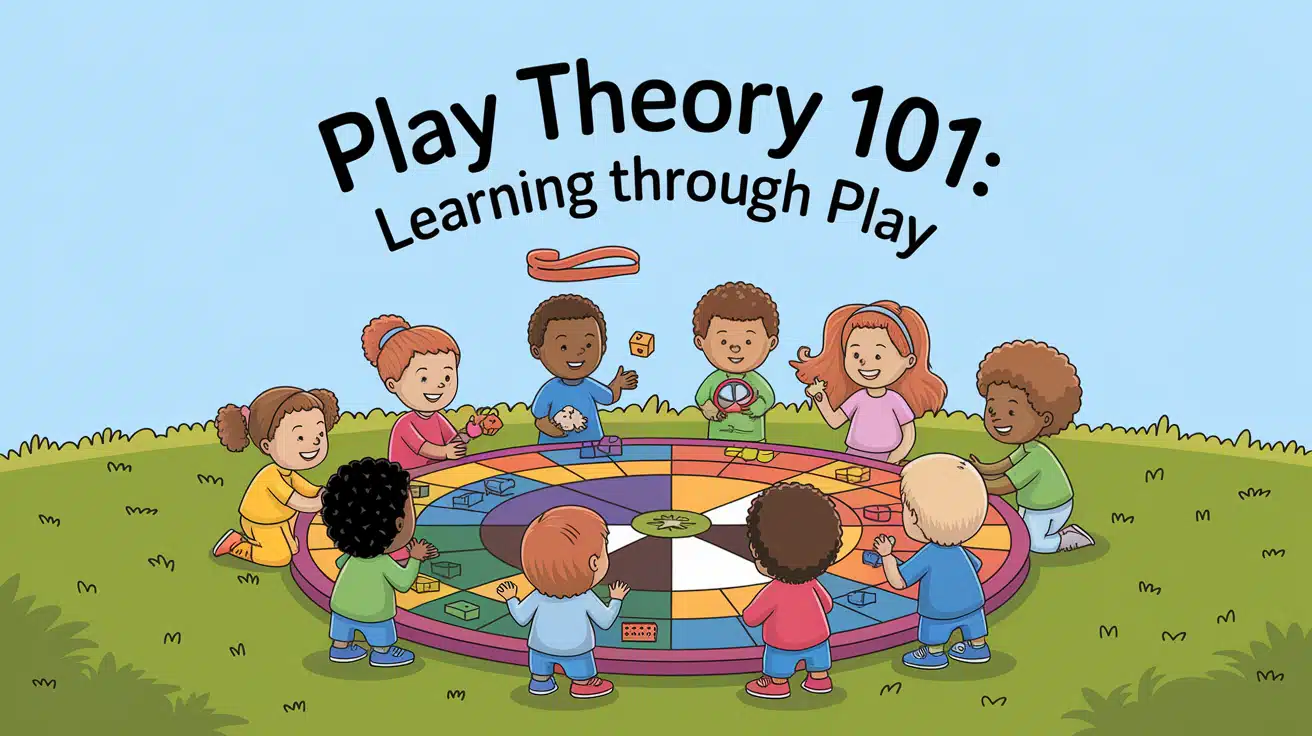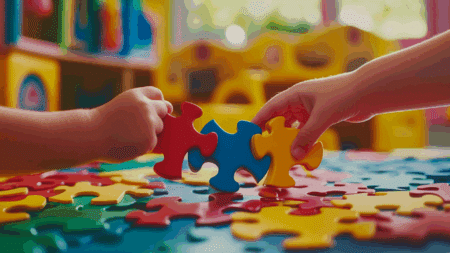Have you ever watched a child completely lost in play and wondered what was really happening? Play theory shows us that these small moments actually build children’s brains.
Play theory explains how children’s natural play time helps them gain essential skills and understanding about the world.
In this blog, we’ll explain the core theories of play from Piaget, Vygotsky, Froebel, and Montessori that continue to influence our understanding of childhood learning.
We’ll also explain the latest research on play’s impact on brain development and provide practical ways to apply these theories at home and in educational settings.
Understanding Play Theory
Instead of forcing children to learn in difficult ways, we can use play to help them discover new things on their own. This helps children become the best they can be.
When adults understand play theory, they can be better helpers in a child’s journey of growing up, knowing when to step in and when to let children learn on their own.
Many people have come out with theories about how children play, and some of the core ones are as follows.
1. Piaget’s Theory of Cognitive Development

Jean Piaget showed how children’s play changes as they grow. He found four main stages of play that match how children think at different ages.
Each stage builds on the one before it. Piaget believed that children are active learners who build knowledge through their experiences.
Sensorimotor Stage (0-2 years)
During these early years, babies learn about the world using their senses and movements. They don’t have language yet. They touch, taste, and grab things to know about them.
They understand that objects exist even when they can’t see them. This is called “object permanence.” Play at this stage is very physical and focused on finding out what things do.
Play Activities include:
- Peek-a-boo games
- Shaking rattles to hear sounds
- Stacking and knocking down blocks
- Water play with cups and toys
Preoperational Stage (2-7 years)
Now, children can use symbols and words. Their imagination grows a lot during this time. A box might become a car or a castle. They often talk to themselves while playing.
They see things mostly from their own point of view. This is when make-believe play becomes very important for learning.
Play Activities include:
- Dress-up and role play (playing store, doctor, or family)
- Simple board games
- Drawing and coloring
- Building with blocks to make “houses” or “castles”
Concrete Operational Stage (7-11 years)
Children now think more logically, understand numbers better, can group things by different features, and start to see other people’s points of view.
They enjoy games with rules and can follow steps in order. Play becomes more social and organized.
Play Activities include:
- Card games and board games with rules
- Sports and team games
- Building complex structures with Lego
- Science experiments with real objects
Formal Operational Stage (11+ years)
In this stage, children can think about abstract ideas, imagine “what if” situations, and consider many possible solutions to a problem.
They enjoy testing theories and solving complex puzzles, and they like to debate ideas with friends.
Their play often includes planning and thinking strategically.
Play Activities include:
- Strategy games like chess
- Video games that require planning
- Group projects with friends
- Puzzles and brain teasers
2. Vygotsky’s Sociocultural Theory

Vygotsky believed that children learn best through social interactions with others, not just through independent learning.
His most important idea is the “zone of proximal development” (ZPD), which describes the spot between what a child can do alone and what they can accomplish with help from someone more skilled.
For example, a child might struggle to complete a puzzle alone but succeed with gentle hints from an adult.
Teachers and parents use this concept when they provide just enough support to help children master new skills without doing everything for them.
Role-playing is central to Vygotsky’s theory because it allows children to practice social behaviors and develop thinking skills.
When children pretend to be doctors, teachers, or parents, they’re actually rehearsing important social rules, using language in new ways, and seeing the world from different perspectives.
This type of play helps children develop self-control as they follow the “rules” of their pretend scenario (like speaking softly in a “library”) and builds their skills to plan and problem-solve together.
Vygotsky believed that children tend to learn new skills and ideas by watching and interacting with others.
3. Froebel’s Holistic Approach to Play

Friedrich Froebel, known as the “father of kindergarten,” made a play-based approach to early education that respects children’s natural curiosity and creativity.
Friedrich Froebel created kindergarten because he believed children learn best through play. He saw that children need to touch, move, and find things to really understand them.
Froebel designed special play materials called “gifts” and activities called “occupations” to support children’s learning through sensory experiences.
Froebel made special toys called “gifts” for children to play with. These were simple things like soft balls, wooden blocks, and shapes. Each toy was designed to teach children something important.
For example, building with blocks helps children learn about balance, counting, and shapes. When children use their hands to develop and create, they learn ideas that words alone can’t teach them.
Through creative play with natural materials like clay, paper, and yarn, Froebel believed children express their inner thoughts and develop fine motor skills.
His approach encourages children to sing, dance, and garden, connecting their learning across physical, emotional, and intellectual domains.
This holistic view recognizes that when children engage all their senses in play, they develop a deeper understanding of themselves and the world around them.
4. Montessori’s View on Play as Learning

Maria Montessori saw that children learn best when they can touch and try things for themselves. She noticed that children don’t just want pretend toys, they want to do real things like adults do.
In Montessori classrooms, children use real tools that are just their size. They wash dishes, prepare food, water plants, and clean up spills. This kind of play teaches them real skills and makes them feel proud.
Montessori made special learning toys that children can work with on their own. These toys are clever because they show children if they’ve done something right without a teacher having to tell them.
For example, if puzzle pieces don’t fit, children know to try again. This helps children learn to solve problems by themselves.
Montessori believed children learn through their senses – touching, seeing, hearing, and moving. Her special materials help children use their senses while they play and learn. Children get to choose what they want to work with, which makes learning more fun.
This freedom helps children become good at focusing, using their hands, making choices, and loving to learn new things.
5. Mildred Parten’s Stages of Play

Mildred Parten watched how children played together and noticed that their social play developed in stages as they grew.
Her research in the 1930s identified six distinct stages that show how children move from playing alone to playing in complex groups.
These stages help parents and teachers understand what’s normal for different ages and how to support children’s social development.
Unoccupied Play (0-3 months)
Babies aren’t really “playing” yet. They make random movements and observe what’s around them. They might wave their arms, kick their legs, or watch a mobile spin.
This early stage helps babies learn about their bodies and start connecting with their environment.
Solitary Play (0-2 years)
Young children play completely independently. They’re focused on their own activities and don’t notice or care what other children are doing.
A toddler might stack blocks or look at a book while sitting right next to another child without interacting. This independent play helps children develop concentration and explore at their own pace.
Onlooker Play (2 years)
Children watch others play but don’t join in. They might stand near a group of kids building a sand castle, asking questions or commenting, but not helping build.
This stage is important for learning social rules by observation before trying them out.
Parallel Play (2-3 years)
Children play side by side with similar toys but don’t really interact. Two preschoolers might sit at the same table drawing, using the same crayons, but each is creating their own picture without collaborating.
This is the beginning of social awareness – being near others while still doing your own thing.
Associative Play (3-4 years)
Children play together and interact but without organized goals or rules. They might all dig in the sandbox, borrow each other’s shovels, and talk about what they’re finding, but they’re not trying to build something specific together.
This stage develops important social skills like sharing, taking turns, and communicating.
Cooperative Play (4+ years)
Children organize their play around shared goals and assigned roles. For example, they might play “restaurant” where one child is the chef, another the server, and others are customers.
This most advanced stage of play requires children to negotiate, problem-solve, and work as a team – skills they’ll use throughout life.
Understanding these stages helps adults recognize that younger children aren’t being “antisocial” when they play alone or alongside others without interacting.
6. Schiller’s Creativity and Emotional Balance in Play

Friedrich Schiller believed that play helps people become creative and emotionally healthy. He thought play was important not just for children but for everyone throughout their lives.
Schiller saw play as a safe way to try out new ideas and feelings. When children build forts or pretend to be superheroes, they’re exploring different ways of thinking and being without any real risks.
This freedom helps them think of new ideas that don’t exist yet.
Play helps balance two important parts of being human, our feelings and our thinking. When children play, they bring these two parts together.
For example, when a child is upset but uses dolls to show how to solve a problem, they’re learning to handle emotions through creative thinking.
Play also gives children a natural way to work through tough feelings. A child might pound clay when angry, draw pictures after feeling sad, or act out scary things in a safe way.
This helps children understand their feelings and learn to manage them. These emotional skills will help them throughout their whole lives.
Practical Applications of Play Theories
By applying these theories in homes, classrooms, and care settings, adults can create play experiences that support development.
To Support Cognitive Development
One simple strategy is to provide open-ended materials like blocks, art supplies, and natural objects. These materials let children experiment, solve problems, and think creatively.
For example, wooden blocks can teach math concepts when children count them, sort them by size, or create patterns.
Asking good questions during play helps children think deeper. Instead of saying, “What a nice tower,” try asking, “How did you make it stand so tall?” or “What might happen if you add one more block?”
These questions ask children to predict, analyze, and explain their thinking.
Creating challenges within play builds problem-solving skills. Setting up a pretend store where children need to make changes or building a bridge that can hold a certain weight helps them apply their knowledge to real situations.
Educators can also use guided play, where they join children’s activities to gently introduce new concepts.
For instance, adding measuring cups to water play introduces volume concepts, or suggesting roles in dramatic play can increase vocabulary and social understanding.
Creating Play-Based Learning Environments
The physical setup of a classroom greatly affects how children play and learn. A well-designed environment supports all types of play and meets diverse learning needs.
To encourage pretend play, create clearly defined areas with props related to children’s experiences.
For example, a home corner with kitchen items, a store with cash registers and products, or a doctor’s office with medical tools helps children practice social roles and language skills.
Physical play needs both indoor and outdoor spaces where children can move freely. Climbing equipment, balls, balance beams, and dancing areas help develop coordination, strength, and spatial awareness.
Even in limited spaces, teachers can create movement zones with tape marks on the floor for jumping or hopping games.
Provide building materials of different sizes and textures for constructive play. Block areas should have enough space for children to build and enough time for complex structures to develop.
Adding clipboards and pencils nearby encourages children to plan and document their structures.
Social play thrives when classrooms include spaces where small groups can gather. Cozy corners with pillows, puppet theaters, or game tables invite children to interact.
Having enough materials (but not too many) encourages sharing and negotiation.
The most effective learning environments change based on children’s interests. Observing what excites children and adding related materials.
For example, if children show interest in birds outside the window, adding bird books, binoculars, and feathers can root deeper learning.
Modern Research on Play

Recent advances in child development research continue to validate classic play theories.
Today’s researchers are observing how play adapts to our changing world, particularly with the technology and new educational approaches.
Technology in Play-Based Learning
Technology has changed how children play and learn, creating opportunities and challenges for their development. When thoughtfully used, digital tools can enhance traditional play experiences rather than replace them.
Interactive apps and games can extend hands-on learning when they’re designed with educational principles in mind.
Augmented reality (AR) creates exciting bridges between physical and digital play. Apps that bring storybooks to life or transform drawings into animated characters. These technologies can be especially great for children who struggle with traditional learning approaches.
Technology can also make play more inclusive. Adaptive devices and specialized software help children with physical or cognitive challenges participate in play experiences that might otherwise be inaccessible.
Digital tools can provide scaffolding that gradually fades as children develop skills.
However, balance remains crucial. Research shows that screen-based play lacks important sensory experiences that physical play provides.
The most effective approach combines technology with hands-on activities and social interaction.
For example, a nature app might identify plants during an outdoor exploration, upgrading rather than replacing the physical experience.
New Trends in Play-Based Education
Neuroimaging studies show that diverse play experiences actually build neural connections that form the foundation for later academic learning. Researchers have found that open-ended play activates different brain regions than more structured activities.
Risk-taking in play has found new attention, with studies suggesting that appropriate risk helps children develop resilience and self-regulation.
“Adventure playgrounds” that include loose parts, tools, and challenging physical elements allow children to assess and manage risk within safe boundaries.
Researchers are studying indigenous play practices and community-based approaches to learning, revealing diverse pathways to development. This cross-cultural research shows that while play is universal, its forms and values reflect cultural contexts.
Intergenerational play programs bring together young children with older adults, benefiting both groups. These programs show promising results for children’s language development and social skills while also reducing isolation among seniors.
The rich interactions between generations create unique learning opportunities that peer-only play cannot provide.
As research continues to show play’s critical role in healthy development, more educational systems are adopting play-based approaches even into elementary grades.
These schools mix academic learning through play experiences rather than separating “work” from “play,” resulting in stronger engagement and deeper understanding.
Conclusion
Play theory reveals the profound importance of play in how children learn and develop.
Whether you’re a parent, teacher, or caregiver, understanding play theory gives you powerful tools to support children’s development.
Knowing about these play theories can help parents and teachers create better play spaces and activities that help children grow in all areas.
Please read our other blogs to learn more about creating better learning for the children in your life!




